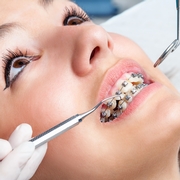Orthodontics

Caring for Your Teeth and Gums During Orthodontic Treatment
If you've decided to have orthodontic treatment, you'll know what an important step you're taking towards improving the look of your teeth. And if you're already wearing your braces, no doubt you're looking forward to the day they come off - to reveal your new smile! But the benefits of orthodontic treatment go way beyond looks. Crooked or crowded teeth may cause uneven wear of tooth surfaces or jaw problems that may lead to complications later in life. They can also be difficult to clean properly, which makes them prone to tooth decay and gum disease.
So, while you're wearing braces, remember that the success of your treatment is affected by how well you care for your teeth and gums. Good oral care at home involves effectively removing plaque from your teeth, gums and braces every day. Not only will it keep your treatment time on course, but it will also contribute to the continued health of your teeth and gums.
How do I keep my teeth and gums healthy?
The key to healthy teeth and gums is proper plaque removal every day. Plaque is the sticky colorless film of bacteria that is constantly forming on your teeth. If it is left to build up, it is one of the main causes of tooth decay and gum disease.
Follow these simple instructions and you'll be off to a great start:
- Brush your teeth, gums and braces at least three times a day (and especially after eating).
- Clean between the teeth at least once daily - and definitely before you go to bed.
- Use a fluoride toothpaste - fluoride is proven to help prevent cavities.
- Use a fluoride mouth rinse at least once daily to help reduce the risk of cavities.
Try to carry your toothbrush and floss with you at all times so that you can clean your teeth even when you are not at home.
How do I clean all areas of my mouth while wearing braces?
At first, doing a good job removing plaque from your teeth and along the gum line may seem difficult with braces. But keep at it - with a bit of practice it will get easier! Following these tips will also help:
First, take off any removable parts like elastic bands and headgear.
Place your toothbrush at an angle of about 45 degrees to the gum and apply gentle pressure as you brush with a gentle back and forward, up and down, or round and round motion. Clean each tooth individually for about 10 seconds.
Use the same brushing motion on the inner and outer surface of all teeth.
Don't forget to brush the chewing surfaces of your teeth - and make sure you reach the back teeth too,
Finish by cleaning around your braces, brushing first from the top and then from the bottom. Brush gently and take care not to bend or break any of the brackets or wires
How often should I clean my braces?
It is vital that you clean your braces every time you brush your teeth. Braces can act as a "plaque trap", increasing the amount of plaque on your teeth, which in turn can lead to an increased risk of caries and gum disease.
How do I floss with fixed braces?
Flossing removes the plaque between your teeth and under your gum line - areas beyond the reach of your toothbrush. In fact, if you don't floss, you're leaving up to 40% of your tooth surfaces untouched and uncleaned.
Choose a threading floss with a stiffened end that threads it through the gap between each tooth - above the wire for your upper teeth and below the wire for your lower teeth.
Curve the floss around each tooth in a "C" shape and gently move it up and down the side of each tooth, including under the gum line. Unroll a new section of floss as you move from tooth to tooth.
Which products are best for braces?
Orthodontic toothbrushes have bristles trimmed in a "V" shape for cleaning above and below the brackets and wire.
Power toothbrushes can remove more plaque than ordinary manual toothbrushes. Some of the newer ones have brush-heads specifically made for use with braces.
Interdental brushes have very small heads with fine bristles - perfect for cleaning under the wires and between the teeth. Check with your orthodontist how you should clean around your braces with this type of brush.
Irrigation devices use a pressurized stream of water (or mouth rinse) to clean around the braces and along the gum line. Most have lower settings for sensitive areas.
An orthodontist may recommend using a combination of home care products in your daily routine.
Cleaning a removable appliance (plate)
Take the appliance out of your mouth and clean your teeth in the normal way. Then use your toothbrush and toothpaste to clean the appliance. Rinse your mouth with water afterwards.
Make sure that you gently brush the gum areas which are covered by the appliance including the roof of your mouth if you wear the appliance on your top teeth.
Do I still need to see my regular dentist?
Yes! Your regular dentist and orthodontist will work together with you to help you do the best job possible in caring for your teeth and gums.